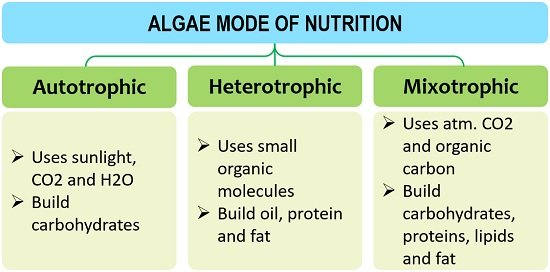The mode of nutrition in algae is primarily of three types, namely photoautotrophic, heterotrophic and mixotrophic. Algae show some properties similar to plants due to the presence of chloroplasts and eukaryotic cellular construction. Also, they share some features similar to animals in having flagella and centriole.
Algae represent a group of highly diversified organisms that exist in different forms and sizes. They generally appear single or multicelled and exist in solitary, chains or filamentous forms.
The majority of algae are photoautotrophs, which means they can undergo photosynthesis to synthesize their food. Some algae utilize organic nitrogen or carbon sources and nutrients in soil or water to synthesize essential oils, fats and proteins via a heterotrophic mode of nutrition.
A few Algae species show the mixotrophic mode of nutrition, in which they utilize both organic and inorganic sources to fulfil their growth and nutritional needs. This post mainly describes the meaning, types and characteristics of algae along with the different modes of nutrition.
Content: Mode of Nutrition in Algae
Algae Meaning
Algae represent a large group of protists whose body appears simple and thalloid, i.e. they lack true stems, roots and leaves. One characteristic feature of algae is that they lack vascular tissues, i.e. xylem and phloem. They can be single-celled and multicelled. Single-celled or prokaryotic algae belong to the Cyanophyta phylum that includes cyanobacteria or blue-green algae.
However, prokaryotic algae are not considered true algae due to the lack of a well-defined nucleus and specialized membranous structures, thus they are categorized in the domain bacteria. Oppositely, multicelled or eukaryotic algae belong to the kingdom (Protista) and domain (Eukarya). They possess a well-defined nucleus, chloroplast and membrane-bound organelles. Besides that, some eukaryotic algae have pyrenoids within plastids.
Habitat
Algae predominantly grow in aquatic habitats, i.e. fresh and marine water, as well as a few may grow in terrestrial habitats. Some algae inhabit places like tree trunks, stones, snowbanks and many other substrata. A few may live symbiotically with organisms like molluscs, sponges, ciliates and fungi. For instance, lichens show a symbiotic association with cyanobacteria (blue-green algae) and ascomycete fungi.
Types
Depending upon factors like habitat and pigmentation, algae are classified mainly into the following groups:
- Chlorophyta (Green algae): They typically live in freshwater and contain chlorophyll pigment. Sea lettuce, horsehair algae, etc., are examples of green algae.
- Rhodophyta (Red algae): They prevalently inhabit tropical marine environments and contain phycoerythrin pigment. Gracilaria, Euchema, Porphyra, etc., are examples of red algae.
- Phaeophyta (Brown algae): They are prominently found in marine environments and contain fucoxanthin pigment. Seaweed and kelp constitute the largest group of brown algae.
- Xanthophyta (Yellow-green algae): They are the least common species of algae, which mainly inhabit freshwater and marine water. Heterochloris, Misclococcus, Chlorogloea, etc., are examples of yellow-green algae.
- Pyrrophyta (Fire algae): They commonly occur near the oceans and in freshwater. Dinoflagellates and Cryptomonads are examples of fire algae.
- Chrysophyta: It includes golden-brown algae and diatoms. Both the members of diatoms and golden-brown algae are common in fresh and saltwater environments.
- Euglenophyta: It includes Euglenoids that inhabit as fresh and saltwater protists.
Important Terms
There are a few important terminologies related to the different modes of nutrition in algae. Let us take a quick overview of it.
Osmotrophy: It is a common form of feeding mechanism in algae living in aquatic habitats. Organisms undergoing osmotrophy obtain nutrition by the movement of dissolved organic compounds from the water via osmosis. Aquatic algae-like Zygnema, Vaucheria, and Cladophora etc., generally undergo osmotrophy to make food.
Photoautotrophy: It is also called “light eating”. Organisms undergoing photoautotrophy obtain nutrition by the light energy (sunlight) and inorganic sources like atmospheric CO2 and H2O to prepare their food. Aerial algae-like Phyllosiphon, Trentipohlia, Chaetophora and Scytonema etc., undergo photoautotrophy.
Heterotrophy: Algae follow heterotrophic strategies to acquire nutrients from organic carbon and nitrogen sources such as carbohydrates, proteins and fats.
Phagotrophy: It is another type of feeding mechanism found in algae. Organisms undergoing phagotrophy obtain nutrition by engulfing large food particulates from the cell surrounding through phagocytosis or food internalization. Dinoflagellates, Diatoms, and Euglenoids etc., undergo phagotrophy.
Algae Nutrition
Algae typically show three modes of nutrition based on the nutritional and growth requirements, as mentioned in the figure below.

However, the principal mode of nutrition in algae is through “Photoautotrophy” or “Self-feeding”. The others may show some different feeding mechanisms, based on which algae are classified into the following types:
- Obligate phototrophs: Algae belonging to this group primarily obtain nutrition via utilizing inorganic sources like CO2, H2O and sunlight or through photosynthesis. In case of limited sunlight, obligate phototrophic algae sustain life through phagotrophy or osmotrophy.
Examples: Dinobryon divergons, Heterokontophyta, etc. - Obligate heterotrophs: Algae belonging to this group primarily obtain nutrition by a heterotrophic mode. In conditions of limited heterotrophy, they sustain themselves by undergoing phototrophy.
Examples: Dinophyta, Gymnodium gracilentum, etc. - Facultative mixotrophs: Algae belonging to this group obtain nutrition through photoautotrophy as well as heterotrophy.
Example: Dinophyta - Obligate mixotrophs: Algae belonging to this group primarily obtain nutrition through photoautotrophy and need B-complex vitamins, amino acids, and fatty acids for growth.
Examples: Euglena gracilis, Euglenophyta, etc.
Conclusion
They play an essential role in CO2 fixation (nearly 50%). Besides that, algae serve as primary producers for the aquatic organisms or serve as a basis of the food chain in the aquatic ecosystem.
What type of nutrition is found in Green algae?
Green algae have a photoautotrophic mode of nutrition, which means they undergo photosynthesis to synthesize their food via chloroplast.